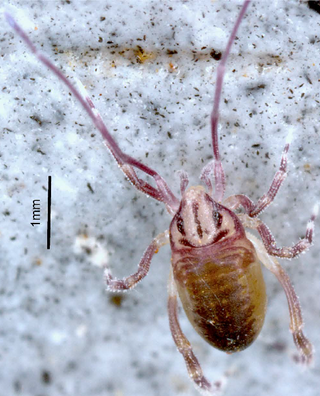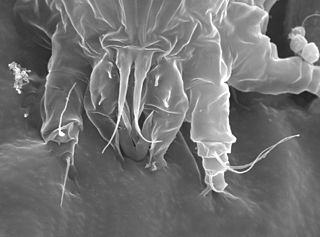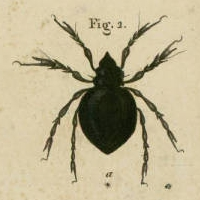
Mites are small arachnids. Mites span two large orders of arachnids, the Acariformes and the Parasitiformes, which were historically grouped together in the subclass Acari, but genetic analysis does not show clear evidence of a close relationship.

The Acariformes, also known as the Actinotrichida, are the most diverse of the two superorders of mites. Over 32,000 described species are found in 351 families, with an estimated total of 440,000 to 929,000 species, including undescribed species.

Parasitiformes are a superorder of Arachnids, constituting one of the two major groups of mites, alongside Acariformes. Parasitiformes has, at times, been classified at the rank of order or suborder.

Opilioacaridae is the sole family of mites in the order Opilioacarida, made up of about 13 genera. The mites of this family are rare, large mites, and are widely considered primitive, as they retain six pairs of eyes, and abdominal segmentation. They have historically been considered separate from other mites belonging to Acariformes and Parasitiformes, but are now generally considered a subgroup of Parasitiformes based on molecular phylogenetics.

Tydeidae is a family of acariform mites. As of 2016, it contained over 300 species in three subfamilies, though more species have been discovered since then.

Eriophyoidea are a superfamily of herbivorous mites. All post-embryonic instars lack the third and fourth pairs of legs, and the respiratory system is also absent.

Lorryia formosa, commonly known as the yellow mite or the citrus yellow mite, is a species of acariform mite. They are in the subfamily Tydeinae of the family Tydeidae. Commonly found on the foliage of citrus trees around the world, Lorryia formosa also associates with a variety of other plant types. The life cycle includes six discrete stages of development, and the lifespan averages about 37 days. The females of the species use an asexual form of reproduction where the growth and development of embryos occurs without fertilization by a male, a process called thelytoky.
Histiostoma is a genus of mites in the family Histiostomatidae.

The Laelapidae are a family of mites in the order Mesostigmata. The family is also referred to in the literature as Laelaptidae, which may be the correct spelling.

Dermanyssoidea is a superfamily of mites, including most of the mites which parasitise vertebrates.
Antennoseius is a genus of mites in the family Ascidae. As of 2021, it comprised 59 species mostly in subgenera Antennoseius and Vitzthumia, as well as six species not assigned to a subgenus.

Rhinonyssidae is a family of mites in the order Mesostigmata. There are about 16 genera and at least 460 described species in Rhinonyssidae.

Brevipalpus phoenicis, also known as the false spider mite, red and black flat mite, and in Australia as the passionvine mite, is a species of mite in the family Tenuipalpidae. This species occurs globally, and is a serious pest to such crops as citrus, tea, papaya, guava and coffee, and can heavily damage numerous other crops. They are unique in having haploid females, a condition caused by a bacterium that change haploid males into females.
Acarophenacidae is a family of mites in the order Trombidiformes that are egg parasitoids and ectoparasites of beetles or thrips. It contains eight genera and around 40 species.

Blattisociidae is a family of mites in the order Mesostigmata.

Belba is a genus of mites belonging to family Damaeidae. The genus was established by Carl von Heyden in 1826. Notaspis corynopus was the type species. Species that are part of the genus can be found in Eurasia and North America.
Phenopelopidae is a family of oribatid mites in the order Sarcoptiformes. As of 2018, there were 4 genera and 106 species known in this family.

Sejida is a suborder of mites in the order Mesostigmata. There are about 5 families and 13 described species in Sejida. The oldest known record of the group is an indeterminate deutonymph belonging to Sejidae from the mid Cretaceous (Albian-Cenomanian) aged Burmese amber of Myanmar.
Melicharidae is a family of mites in the order Mesostigmata.
Aleuroglyphus ovatus, commonly known as brown-legged mite or brownlegged grain mite, is a species of mite in the family Acaridae. It is a cosmopolitan pest of grain.













